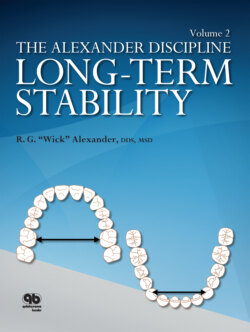Читать книгу The 20 Principles of the Alexander Discipline, Volume 2 - R.G. "Wick" Alexander - Страница 10
На сайте Литреса книга снята с продажи.
The Room of Truth
ОглавлениеAfter a few years in practice, almost every orthodontist has the problem of storing patients’ diagnostic records. In addition to the growing amount of space required, there is also an added burden of finding time to take these final records. With the combination of time, space, and cost involved, virtually all orthodontists stop taking final records as they become busy.
Certain advantages regarding records evolved early in my professional career without my realizing it. In graduate school, we were all taught to take complete pretreatment and posttreatment diagnostic records. Upon entering private practice, because I was teaching, I continued this sequence, and I have continued it to this day. More than 15,000 patients have been treated in our office, and we have full initial and final records for at least 10,000 of them.
One of the few advantages of my age is that many patients I treated years ago have since brought their children in for treatment. When we discover this former relationship, the first thing our staff does is to look into the Room of Truth (Figs 1-1a and 1-1b). This is the room where many of these records are stored. If we have complete records on the parent, we ask to take new postretention records. We have about 300 to 400 of these T3 records (postretention), and the number is growing monthly.
From this room, more than 50 master theses have been written. The majority of students have come from Baylor, but other schools include the University of Texas, University of Alabama, University of Southern California, New York Univeristy, Loyola University, and other schools in Canada, Germany, Mexico, Brazil, and other countries. A large number of these theses have been published. An open-door policy concerning these records has always been in force. Any student in the world is welcome to come study these diagnostic records (Fig 1-1c). The only stipulation is that no records be removed from the office.
Throughout this book, I quote many statements from these research studies that changed some of our concepts on long-term stability from anecdotal to evidence-based information.
In volume one of this series, I attempted to identify the 15 keys to orthodontic stability. Although the keys have not changed, I have consolidated them into six guidelines. Hopefully this book presents to the reader a more precise approach to identifying the goals for long-term stability.
